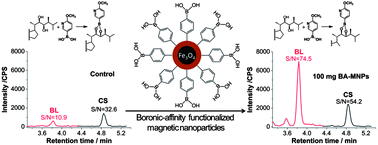A dual role of boronate affinity in high-sensitivity detection of vicinal diolbrassinosteroids from sub-gram plant tissues viaUPLC-MS/MS†
Abstract
Based on the dual role of specific boronate affinity, making use of both novel self-synthesized

* Corresponding authors
a
National Centre for Plant Gene Research (Beijing), Institute of Genetics and Developmental Biology, Chinese Academy of Sciences, Beijing 100101, P. R. China
E-mail:
cunyuyan@genetics.ac.cn, jfchu@genetics.ac.cn
Fax: +86-10-64807658
Tel: +86-10-64806466
b College of Chemical Engineering, Qingdao University of Science and Technology, Qingdao, P. R. China
Based on the dual role of specific boronate affinity, making use of both novel self-synthesized

 Please wait while we load your content...
Something went wrong. Try again?
Please wait while we load your content...
Something went wrong. Try again?
P. Xin, J. Yan, J. Fan, J. Chu and C. Yan, Analyst, 2013, 138, 1342 DOI: 10.1039/C3AN36533F
To request permission to reproduce material from this article, please go to the Copyright Clearance Center request page.
If you are an author contributing to an RSC publication, you do not need to request permission provided correct acknowledgement is given.
If you are the author of this article, you do not need to request permission to reproduce figures and diagrams provided correct acknowledgement is given. If you want to reproduce the whole article in a third-party publication (excluding your thesis/dissertation for which permission is not required) please go to the Copyright Clearance Center request page.
Read more about how to correctly acknowledge RSC content.
 Fetching data from CrossRef.
Fetching data from CrossRef.
This may take some time to load.
Loading related content
